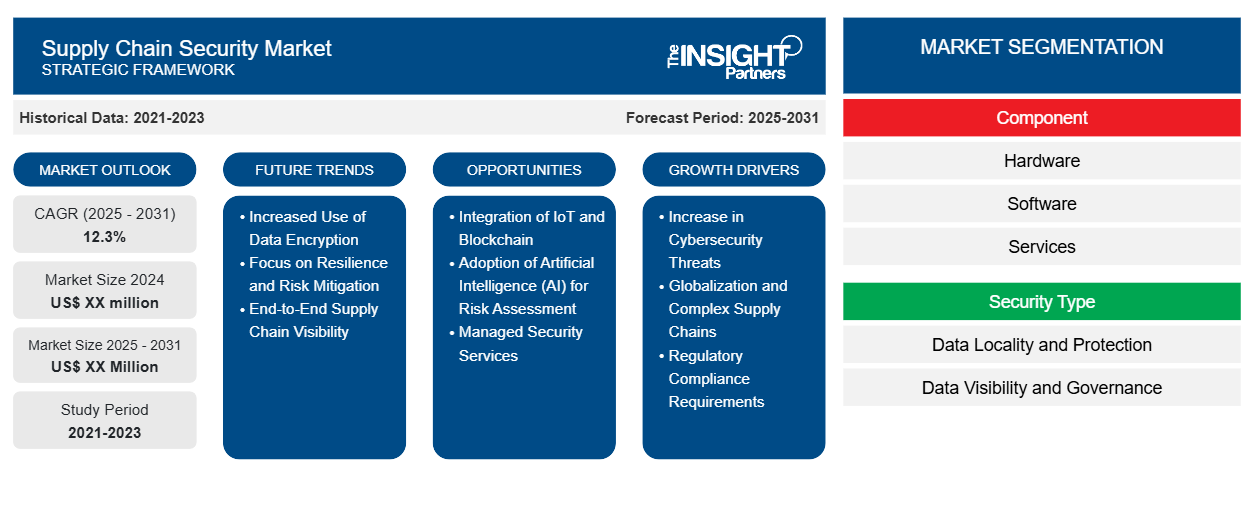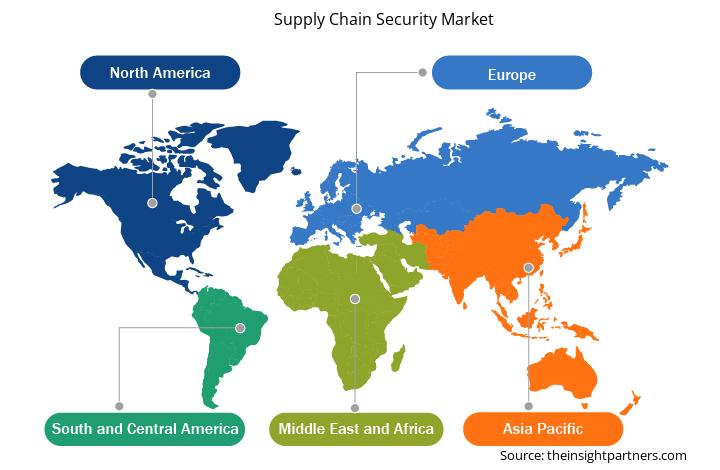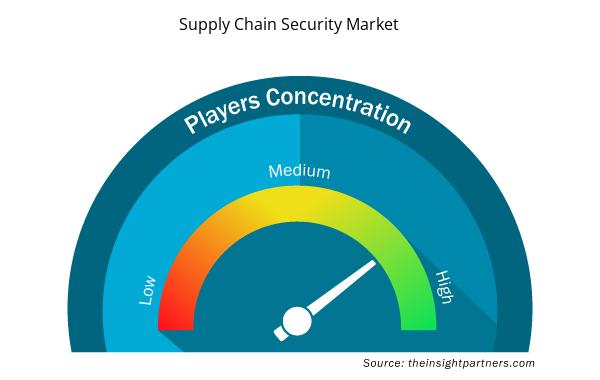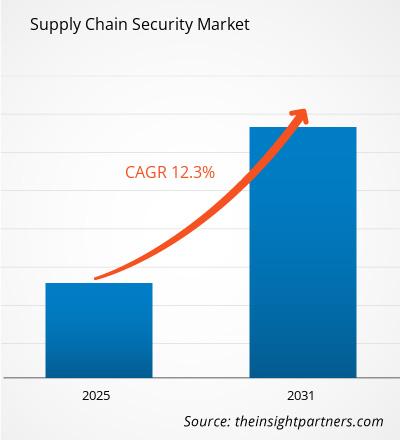The Supply Chain Security Market is expected to register a CAGR of 12.3% from 2025 to 2031, with a market size expanding from US$ XX million in 2024 to US$ XX Million by 2031.
The report is segmented by Component (Hardware, Software, Services), Security Type (Data Locality and Protection, Data Visibility and Governance, Others), Organization Size (SMEs, Large Enterprises), Application (Healthcare & Pharmaceuticals, FMCG, Chemicals, Retail and Ecommerce, Others). The global analysis is further broken-down at regional level and major countries. The report offers the value in USD for the above analysis and segments
Purpose of the Report
The report Supply Chain Security Market by The Insight Partners aims to describe the present landscape and future growth, top driving factors, challenges, and opportunities. This will provide insights to various business stakeholders, such as:
- Technology Providers/Manufacturers: To understand the evolving market dynamics and know the potential growth opportunities, enabling them to make informed strategic decisions.
- Investors: To conduct a comprehensive trend analysis regarding the market growth rate, market financial projections, and opportunities that exist across the value chain.
- Regulatory bodies: To regulate policies and police activities in the market with the aim of minimizing abuse, preserving investor trust and confidence, and upholding the integrity and stability of the market.
Supply Chain Security Market Segmentation
Component
- Hardware
- Software
- Services
Security Type
- Data Locality and Protection
- Data Visibility and Governance
Organization Size
- SMEs
- Large Enterprises
Application
- Healthcare & Pharmaceuticals
- FMCG
- Chemicals
- Retail and Ecommerce
Customize This Report To Suit Your Requirement
You will get customization on any report - free of charge - including parts of this report, or country-level analysis, Excel Data pack, as well as avail great offers and discounts for start-ups & universities
Supply Chain Security Market: Strategic Insights

- Get Top Key Market Trends of this report.This FREE sample will include data analysis, ranging from market trends to estimates and forecasts.
Supply Chain Security Market Growth Drivers
- Increase in Cybersecurity Threats: The growing number of cyberattacks targeting supply chains has highlighted vulnerabilities in logistics and data systems. Cybercriminals often exploit weak points in the supply chain to gain access to sensitive information or disrupt operations. This drives demand for enhanced security solutions that protect the integrity and confidentiality of the entire supply chain process.
- Globalization and Complex Supply Chains: As companies expand their operations across global markets, their supply chains become more complex, with more touchpoints, vendors, and logistics providers involved. This complexity increases the risk of security breaches. The need for comprehensive security strategies to safeguard global supply chains is pushing businesses to invest in better security technologies and protocols.
- Regulatory Compliance Requirements: Governments and regulatory bodies are enforcing stricter regulations related to supply chain security, such as GDPR, CCPA, and specific trade regulations. Companies must adhere to these regulations to avoid penalties and maintain consumer trust. This drives the demand for supply chain security solutions that ensure compliance with data protection and industry standards.
Supply Chain Security Market Future Trends
- Increased Use of Data Encryption: As data privacy concerns grow, there is an increasing trend toward encrypting sensitive supply chain data both in transit and at rest. By ensuring that critical information, such as transaction data and shipment details, remains unreadable without proper authorization, businesses are mitigating the risk of data breaches and maintaining regulatory compliance.
- Focus on Resilience and Risk Mitigation: In response to recent disruptions like the COVID-19 pandemic and natural disasters, organizations are focusing on creating resilient supply chains. The trend is shifting from merely securing supply chains to ensuring they are adaptable and capable of recovering from disruptions. Companies are investing in security technologies that also help build robust, flexible supply chain models to better withstand risks.
- End-to-End Supply Chain Visibility: There is an increasing trend toward achieving end-to-end visibility across the supply chain to improve monitoring and security. This includes tracking shipments, managing inventory, and monitoring supplier performance. Real-time tracking and surveillance help identify potential threats and vulnerabilities early on, enabling companies to take proactive measures to prevent disruptions.
Supply Chain Security Market Opportunities
- Integration of IoT and Blockchain: The integration of Internet of Things (IoT) and blockchain technologies in supply chain security offers enhanced visibility and traceability. IoT devices provide real-time monitoring of goods and shipments, while blockchain ensures the integrity of data transactions. This combination offers businesses the opportunity to improve transparency and prevent fraud, theft, or unauthorized tampering within the supply chain.
- Adoption of Artificial Intelligence (AI) for Risk Assessment: AI and machine learning can be leveraged to predict and mitigate risks in supply chains. By analyzing large datasets and identifying patterns, AI can help detect potential security breaches before they occur. This opportunity allows businesses to proactively address vulnerabilities, optimize security measures, and reduce the chances of supply chain disruptions due to security incidents.
- Managed Security Services: Many companies, especially small and medium-sized enterprises, lack the resources to handle complex supply chain security independently. The rise of managed security service providers (MSSPs) offers an opportunity for businesses to outsource supply chain security management. MSSPs can provide expertise in securing digital systems, data, and physical goods, enabling companies to focus on core operations while ensuring secure supply chains.
Supply Chain Security Market Regional Insights
The regional trends and factors influencing the Supply Chain Security Market throughout the forecast period have been thoroughly explained by the analysts at Insight Partners. This section also discusses Supply Chain Security Market segments and geography across North America, Europe, Asia Pacific, Middle East and Africa, and South and Central America.

- Get the Regional Specific Data for Supply Chain Security Market
Supply Chain Security Market Report Scope
| Report Attribute | Details |
|---|---|
| Market size in 2024 | US$ XX million |
| Market Size by 2031 | US$ XX Million |
| Global CAGR (2025 - 2031) | 12.3% |
| Historical Data | 2021-2023 |
| Forecast period | 2025-2031 |
| Segments Covered |
By Component
|
| Regions and Countries Covered | North America
|
| Market leaders and key company profiles |
Supply Chain Security Market Players Density: Understanding Its Impact on Business Dynamics
The Supply Chain Security Market market is growing rapidly, driven by increasing end-user demand due to factors such as evolving consumer preferences, technological advancements, and greater awareness of the product's benefits. As demand rises, businesses are expanding their offerings, innovating to meet consumer needs, and capitalizing on emerging trends, which further fuels market growth.
Market players density refers to the distribution of firms or companies operating within a particular market or industry. It indicates how many competitors (market players) are present in a given market space relative to its size or total market value.
Major Companies operating in the Supply Chain Security Market are:
- IBM
- Emerson
- Oracle
- NXP Semiconductors
- Testo
- ORBCOMM
Disclaimer: The companies listed above are not ranked in any particular order.

- Get the Supply Chain Security Market top key players overview
Key Selling Points
- Comprehensive Coverage: The report comprehensively covers the analysis of products, services, types, and end users of the Supply Chain Security Market, providing a holistic landscape.
- Expert Analysis: The report is compiled based on the in-depth understanding of industry experts and analysts.
- Up-to-date Information: The report assures business relevance due to its coverage of recent information and data trends.
- Customization Options: This report can be customized to cater to specific client requirements and suit the business strategies aptly.
The research report on the Supply Chain Security Market can, therefore, help spearhead the trail of decoding and understanding the industry scenario and growth prospects. Although there can be a few valid concerns, the overall benefits of this report tend to outweigh the disadvantages.
- Historical Analysis (2 Years), Base Year, Forecast (7 Years) with CAGR
- PEST and SWOT Analysis
- Market Size Value / Volume - Global, Regional, Country
- Industry and Competitive Landscape
- Excel Dataset


- Online Exam Proctoring Market
- Small Internal Combustion Engine Market
- Thermal Energy Storage Market
- Medical Second Opinion Market
- Airline Ancillary Services Market
- 3D Audio Market
- Fish Protein Hydrolysate Market
- Biopharmaceutical Contract Manufacturing Market
- Visualization and 3D Rendering Software Market
- Microcatheters Market

Report Coverage
Revenue forecast, Company Analysis, Industry landscape, Growth factors, and Trends

Segment Covered
This text is related
to segments covered.

Regional Scope
North America, Europe, Asia Pacific, Middle East & Africa, South & Central America

Country Scope
This text is related
to country scope.
Frequently Asked Questions
Some of the customization options available based on the request are an additional 3–5 company profiles and country-specific analysis of 3–5 countries of your choice. Customizations are to be requested/discussed before making final order confirmation# as our team would review the same and check the feasibility
The report can be delivered in PDF/PPT format; we can also share excel dataset based on the request
Increased Use of Data Encryption, Focus on Resilience and Risk Mitigation, End-to-End Supply Chain Visibility
Increase in Cybersecurity Threats, Globalization and Complex Supply Chains, Regulatory Compliance Requirements
The global Supply Chain Security market is expected to grow at a CAGR of 12.3% during the forecast period 2024 - 2031

 Get Free Sample For
Get Free Sample For